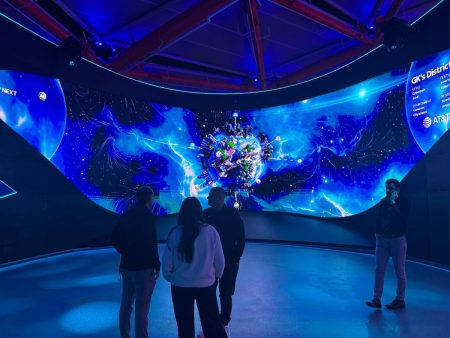Is something weird happening to our sun? If you read the headlines you’d be forgiven for thinking so. CNN reported in June that the sun’s activity is peaking sooner than expected, Live Science followed in July with a story stating that solar maximum could hit us harder and sooner than we thought and this week Science reports that peak solar activity is arriving sooner than expected.
It’s not true. Solar maximum is not confirmed to be arriving sooner than expected. Years ago this peak in the sun’s activity—something that occurs roughly every 11 years—was predicted to occur in 2025. That’s not changed.
“Around May, June and July when these articles started coming out the sunspot number was really high, but in the last few months it’s come back down,” said Dr. Ryan French, a solar physicist at the National Solar Observatory (NSO) in Boulder, Colorado and the author of The Sun: Beginner’s Guide To Our Local Star, which publishes in the U.S. today. In August there were 115 sunspots, a huge decrease from May’s 138, June’s 163 and July’s 159. If there was a spike, it’s been interrupted.
French also tweeted recently that there are fewer solar flares coming from the sun than what we’d expect from this point in the solar cycle.
Sunspots Explained
Sunspots are magnetic disturbances on the surface of the sun that can be as big as Earth. They’ve been counted every day since 1611, according to NASA, enough data for scientists to tease out 25 separate solar cycles, each lasting roughly 11 years, during which the number of sunspots has been observed to wax to a “solar maximum” and wane to a “solar minimum.”
“The steeper the solar cycle and the higher the peak in sunspots, the shorter the solar cycle,” said French in an interview. “Cycles with a lower peak will be slightly longer than 11 years and cycles with a higher peak will be slightly shorter than 11 years.” The articles about solar maximum arriving early were based on higher than expected sunspot numbers.
So the headlines are a bit like taking the half-time score in a football game and declaring that team champion.
Predicting Solar Maximum
The solar physics community is trying to predict when solar maximum will occur, with the new era of algorithms, machine learning and AI fueling new models that attempt to pin it down in new ways.
But there are basically two competing computer models—one used by the National Oceanic and Atmospheric Administration/NASA (used by NOAA’s Space Weather Prediction Center) and the other developed by the National Center for Atmospheric Research. A few years ago the former predicted that the new Solar Cycle 25 would be fairly inactive while the latter predicted it could be one of the strongest on record.
Recent headlines basically trump the NCAR model, the evidence being a flurry of sunspots this summer that make the NOAA/NASA model look seriously undercooked.
Splitting The Difference
“At the moment the sun looks like it’s splitting the difference between both of those models because the monthly fluctuations are too large, so it’s too soon to say that either of the models is correct,” said French. “But it’s not about who’s right and who’s wrong.” Each model uses different physics for what’s happening in the interior of the sun, so this is about validating scientific models of how the sun creates space weather. “Predicting the solar cycle and solar maximum specifically is a way to validate scientific models,” said French. “We’re learning things from this process.”
The NCAR model uses a new physical idea called “the terminator” within the sun. This refers to an overlap between one solar cycle ending and another beginning, with the terminator referring to a point where sunspot numbers begin accelerating.
What’s actually happening right now is that both models are being refined using the first few years of the current solar cycle. That is, after all, how science works—and it likely won’t be until the solar maximum has long passed that either model can emerge as being more correct than the other.
Solar Flares And Coronal Mass Ejections
Both models use the fluctuating number of sunspots to predict the solar cycle, which in turn helps solar physicists predict solar activity and, crucially, space weather.
Space weather is split into two major events on the surface of the sun that can have consequences for Earth—solar flares and coronal mass ejections.
Solar flares are powerful bursts of radiation that typically erupt from sunspots and travel at the speed of light. If they’re directed at Earth they arrive in just over eight minutes and trigger a geomagnetic storm. They’re often followed by coronal mass ejections, huge clouds of magnetic fields and plasma hurled into space at up to 1,900 miles (3,000 kilometers) per second. When directed toward Earth a CME can—once it arrives a few days later—cause a geomagnetic storm that can change the shape of our planet’s magnetic field to create spectacular displays of aurora.
If either a solar flare or a CME is strong enough it can potentially devastate satellites, harm astronauts and damage electrical grids on the ground. Minor events regularly cause radio outages mariners and short wave radio users.
Beyond Solar Cycles
Trouble is, extreme solar activity isn’t necessarily linked to the solar cycle, which both the NOAA/NASA and NCAR models exist to predict. “The role of solar cycles in space weather can be overstated,” said French. In general, more sunspots means more solar flares and more CMEs, but that’s merely a trend. “Solar maximum doesn’t mean that the biggest flares and solar minimum doesn’t mean everything is safe,” said French.
You only have to go back one solar cycle to find the evidence for that.
That was in Sept. 2017, a month that saw four X-class solar flares—one of them was X9.3 -class—and several powerful CMEs. They came after almost an entire year of a nearly spotless sun and zero solar flares. Also a few years after solar maximum was the “Halloween Storm” of Oct. 31, 2003 when an X35-class struck, causing auroras as far south as Texas and Florida.
However, the biggest ever solar flare recorded—at X45, or thereabouts—was the so-called Carrington Event, when on Sept. 2, 1859, British astronomer Richard Carrington observed a blast of white light from the sun for about five minutes. It, and its resulting CME’s geomagnetic storm caused displays of aurora across the planet, even at the equator, yet few issues to a pre-industrial society save for electric shocks to telegraph operators, according to Live Science. If that happened now it could cause over $41.5 billion of economic loss per day in the U.S., according to a study.
It’s for this reason that solar flare forecasting is done on a sunspot-by-sunspot basis—there are people that measure the complexity of each sunspot and forecast which ones could unleash solar flares.
Chaotic Object
Solar physicists don’t yet know why the solar cycle peaks and dips when it does. “Using these models to make predictions is a way of pushing towards the truth by validating different physical models to try and understand what’s happening,” said French. “But we’re not going to solve everything using one prediction during one solar cycle—it’s part of a long process.”
Being able to understand the sun, and predict and forecast these things coming off the sun is crucial for society, but the sun is a very complex, chaotic object. “If the sun wasn’t complicated I’d be out of a job,” said French.
Wishing you clear skies and wide eyes.
Read the full article here








